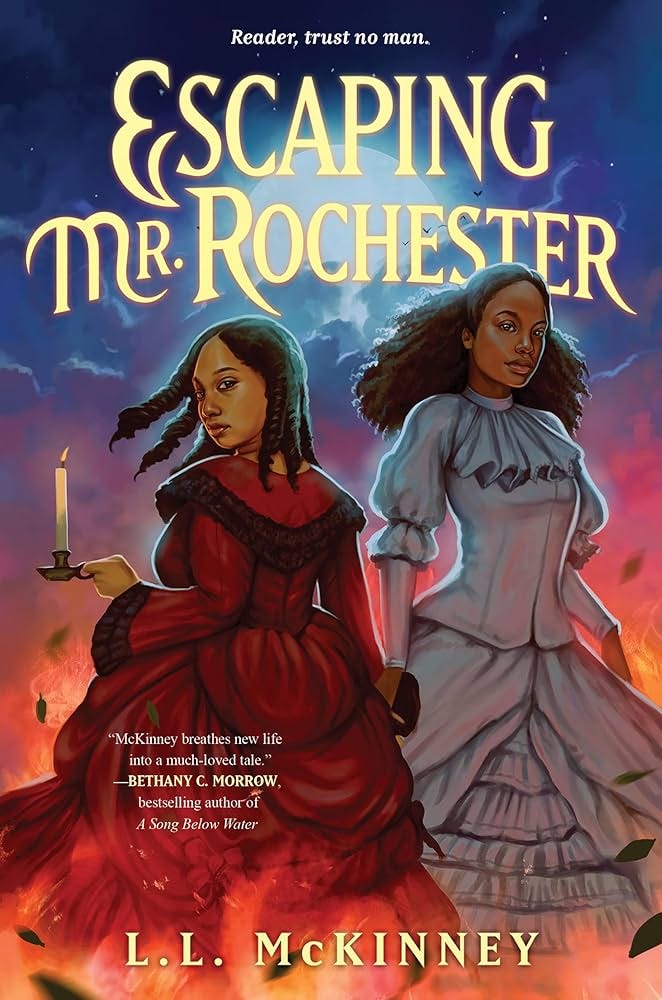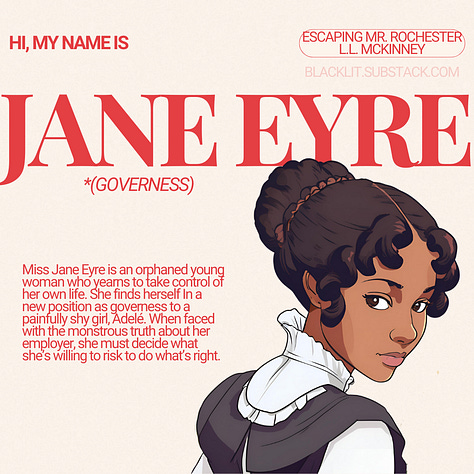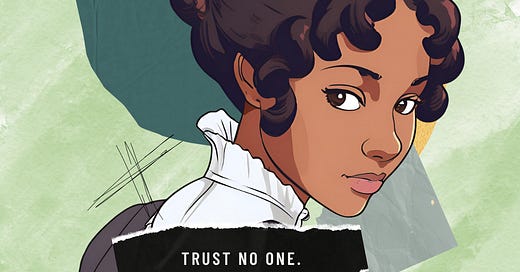TL;DR: In a sapphic retelling of Jane Eyre, Escaping Mr. Rochester positions Mr. Rochester as the villain of the story who’s very easy to root against. Though it leaves a lot to be desired when it comes to romance, it’s an enjoyable spin on a well-known story centering Black women who are taking back control over their lives. A spoiler-free review*
When discussing classics, many people and educational institutions will be quick to have Jane Eyre dancing somewhere in the upper quadrant of that list. Until quarantine, I found even the thought of Jane Eyre painful. What was assigned as required reading left me bored and woefully unamused. However, with nowhere to go but the four walls of my NYC apartment, I found myself taking on the task of re-reading books I once loathed.
With fresh eyes and more life experience, I finally was able to appreciate this Victorian novel. I finally understood what caused so many readers to pine after Edward Rochester. Shrouded in broodiness, means, and an heir of mystery, I grew to not only understand his ‘bad boy’ aesthetic but found room to empathize with each character.
If you’re not familiar with the novel, here’s a quick and dirty summary:
Jane Eyre, the heroine of our story, is orphaned, mistreated by her family members, and sent off to a boarding school that’s just shy of being called a prison. The girl’s got a rough life.
She takes on a job as a governess at Thornfield Hall — a mansion in the middle of nowhere with a lot of unused rooms. Mr. Rochester, the ‘love interest’ in the story, is depicted as dark, brooding, and mysterious. Let’s not forget to mention Mr. Rochester is pushing 40 while Jane is 19 and he’s trifling. The man has more skeletons in his closet than Vybz Kartel.
Jane eventually discovers that Mr. Rochester is not only presently married, but he’s got his wife locked up in the attic. To make matters worse, Bertha is clearly described as a woman of color with this white captor who claims she has a mental illness.
Heartbroken, Jane runs away and eventually finds refuge with a family, The Rivers. The son, St. John Rivers, is handsome and smart but also carries himself with an heir of superiority. He’s very practical and proposes a marriage match with Jane that, to him, makes sense. Jane refuses because she doesn’t want a loveless marriage. Oh, did I mention that they’re cousins?
Jane returns to Thornfield and it’s burned to the ground thanks to Bertha. Unfortunately, she also perished in the fire. Rochester is left blind and oh so sad. Luckily, Jane is there to scrape him off the ground and marry him.
Are you still with me? That’s the original story. If you’re someone who loves messy drama and you haven’t read Jane Eyre yet, add it to your TBR. While perusing the new list of titles Austin Public Library now carries, I came across a newer retelling of this classic tale and decided to check it out … of the library that is.

Book Blurb
In this fresh reimagining of Charlotte Brontë’s classic novel by acclaimed author L. L. McKinney, Jane Eyre, and Bertha Mason must save each other from the horrifying machinations of Mr. Rochester in this intrigue-filled, empowering young adult romance.
Jane has no interest in a husband. Eager to make her own way in the world, she accepts the governess position at Thornfield Hall.
Though her new employer, Edward Rochester, has a charming air—not to mention a handsome face—Jane discovers that his smile can sharpen in an instant. Plagued by Edward’s mercurial mood and the strange wails that echo through the corridors, Jane grows suspicious of the secrets hidden within Thornfield Hall—unaware of the true horrors lurking above her very head.
On the topmost floor, Bertha Mason is trapped in more ways than one. After her whirlwind marriage to Edward turned into a nightmare, he locked her away as revenge for withholding her inheritance. Now his patience grows thin in the face of Bertha’s resilience and Jane’s persistent questions, and both young women are in more danger than they realize.
When their only chance at safety—and perhaps something more—is in each other’s arms, can they find and keep one another safe before Edward’s dark machinations close in around them?
Review
Content warnings: Domestic abuse, death of a parent, murder, gun violence, kidnapping and captivity
Rating: 3.5 out of 5






characters linked here
In this sapphic retelling of a classic tale, readers meet a young governess, Jane, determined to create her way in the world. She is called by letter to take on a young ward at Thornfield Hall. Promised decent wages and room and board, she opts to take on this seemingly unassuming job.
From the moment the carriage comes to pick her up to transport her to her place of employment, things are just off. The driver has an attitude and reeks of alcohol. Things just get more uncomfortable as she meets the other staff members in the house, her young ward, and her employer.
Half of the house is off-limits. She’s explicitly told as much. She finds herself drawn to explore the dark, dusty halls of Thornfield Hall. Especially since she can’t shake the feeling that something isn’t right. After all, she swears she hears wailing. Is it a ghost?
…There are nights when I have trouble sleeping. I find lavender tea helps. Sometimes, on my way to or back from the kitchen, I hear it. It’s faint, but I’m fairly certain someone is crying. A woman, maybe a child. (Jane, Ch 12)
We follow Jane as she unfolds all of the secrets and lies of Thornfield Hall and she discovers, that everyone is lying to her.
Here’s where it loses points for me:
Lack of exposition
Very little romance
Generally speaking, I’m a sucker for historical fiction so this was perfectly poised to be right up my alley. Set against the backdrop of Jane Eyre, I came into the book expecting the usual pulling of important details from the source material. Straight away, we were dropped into the story seeing Jane off Thornfield Hall. With brief mentions of people from her past, namely Helen, sprinkled throughout the book, this tale lacks a bit of exposition.
In some regards, I feel like L.L. McKinney relied too heavily on readers’ familiarity with the source material. With Jane Eyre, Brontë spent quite a bit of real estate building out Jane’s character and the nuances of her personality. Within the covers of Escaping Mr. Rochester, we are only faced with the details of Jane that depicts a strong young woman who is determined to have a life she can call her own. Without details about her time at Lowood or her friendship with Helen, it’s hard to find a point of connection with her character.
On the other hand, McKinney spends a good chunk of time detailing Bertha’s life. I have a suspicion that this has more to do with the fact that the source material does not provide context for this version of the character. Through having to create a picture of this ‘tricked into captivity’ Bertha, we were able to garner details about supporting characters that would have otherwise been left out or deemed insignificant.
In the original title, Bertha is older than Mr. Rochester. Except for Jane and Adelé, McKinney skirts around the age of the characters. With readers left to fill in the gaps themselves, readers are forced to take educated guesses regarding everyone’s age in relation to Jane’s who, we know, is 19 years old:
This driver is not the first to show such unkindness in my nineteen yars, and he will not be the last. (Jane, Ch 1)
Using this information, we have to surmise that Bertha is between the ages of 18 and 21 based on the fact that she perceives Jane to be around her age.
She calls to someone and seconds later a woman who looks to be about my age joins her. The governess. (Bertha, Ch 19)
Mr. Rochester is still positioned as an older man with an established estate. At a minimum, he has to be about 30 years old in this retelling. If this is in fact the wrong assumption to make, then the gross power dynamics that existed in the original novel still exist except, this time, it’s ✨sapphic✨. In the original story, Bertha is about 10 years older than Mr. Rochester so for this story to happen and not be, well, gross, it makes sense why the change was made.
Lastly, for this to be a romance, it was severely lacking. Save for a few kisses, the on-page romance was nonexistent.
The same sort of expression Charlotte wore the first time she pulled me into the drawing room of her family’s house and her lips found mine in the dimness of a cloudy afternoon that was brighter from that moment forward. (Bertha, Ch 13)
I say nothing, because nothing needs to be said. Instead, I take the reins in one hand so I can qrap my arm around her. I pull her close, her body solid and soft against mine, the scent of her filling my senses. Her eyes find mine in the night. Our lips meet. It’s slow and careful, soft and sweet. And my entire body is abuzz with it...and then I’m kissing her again, and all I can think about is how she feels. How she tastes. (Jane, Ch 53)
Personally, I don’t like or gravitate toward romance books so to find myself looking for more romance, took me by surprise.
Overall, this is a good book to give a read. I think I may have enjoyed it more if I wasn’t familiar with Jane Eyre, so if you didn’t read it, then read this first.
Read this book if…
You love books about women seeking revenge
You’re new to historical fiction and want a starting point that’s an easy read
You want to read a Black queer love story
You dream of escaping what keeps you trapped
Don’t read this book if…
You need space from literature that mention DV
You need a break from misogyny
Let’s chat:
✎ᝰ.What’s your favorite retelling of a classic? What about it stuck with you?
✎ᝰ.What story would you like to see a retelling of? From what angle?
Thank you for reading. Stay Lit. 📚








